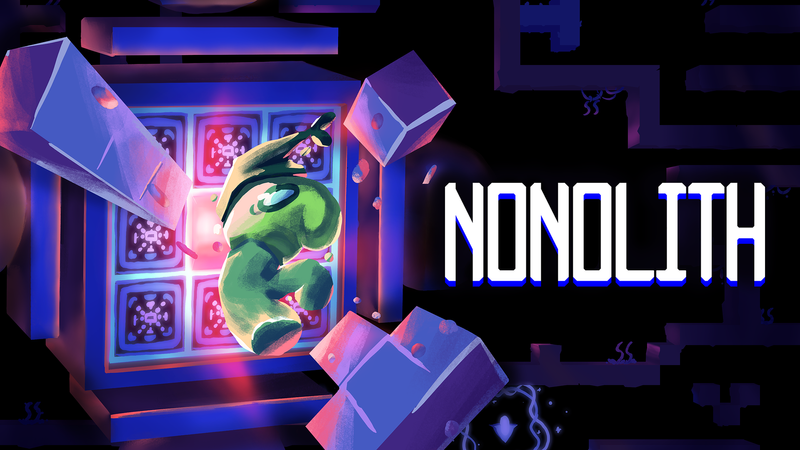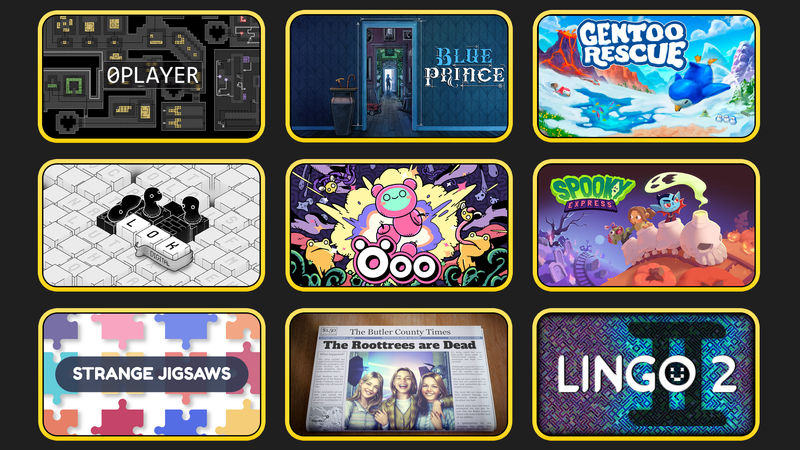From the very first scene, The Rise of The Golden Idol plunges you back into the icy pool of its shocking world. One man stands above another, his foot pushing against the back of the second man’s neck, a belt from a straight jacket wrapped around his windpipe. The first man pulls hard on the belt as the second man writhes on the floor gasping for air, his arm outstretched as he desperately scrambles to reach his baton. It’s distressing, visceral, and a brilliant start to the sequel to one of this decade's best detective games.
In The Rise of the Golden Idol, you’re once again cast as an invisible detective overlooking a string of ghastly scenes. As this omnipresent observer, you pluck out words in the environment to complete fill-in-the-blank statements, trying to deduce what happened. The story continues to follow the titular idol three centuries after the events of the first game as the series' strange alternative reality marches on into the 1970s. Developers Color Gray Games say that you don’t need to have played The Case of the Golden Idol to understand this follow-up, and although that's true, there’s a wonderful satisfaction in mapping the idol’s bloody path, picking up all the delicious breadcrumbs sprinkled throughout this new, grisly saga.
The most obvious difference between the first and second games are the visuals. Crunchy, pixel art has been replaced with a bold, painterly style. Scenes are still presented as frozen snapshots, but there’s more movement in The Rise of the Golden Idol's vignettes. This may seem like a small addition, but the impact is massive. Gestures in the scene - such as the waggle of an accusatory finger or the crackle of an electrified circuit board as a body gets pushed into it - not only punch up the scene's shock factor but also make the events feel more present. Instead of a snapshot frozen in time, these acts of voilence are unfolding before your eyes. The man in the tutorial scenario is being strangled right in front of you and as an observer, you are pulled into the moment. It’s fantastic, if wholly unsettling. This goes for the character portraits too, that twist and bunch making their faces look distorted. Thank god the demon child Lil' Pip doesn't return in this game, I don't think I could stomach his 'glow-up'.
Beyond these twisted visual additions are new puzzle elements. The core fill-in-the-blank mechanic remains the same, but The Rise of the Golden Idol introduces UI changes that make detective work much more streamlined. The constant switching between exploration and thinking screens has been left in the first game and now the fill-in-the-blank statements appear as moveable pop-up windows, letting you observe clues in the scene and fill out the statements simultaneously. This overlay can be toggled off and on with the space bar - letting you instantly minimise them all in one go when your screen gets cluttered. I love this addition as it makes cross-referencing details so much easier than having to scribble down cryptic information on whatever scraps of paper happen to litter your desk.
Other handy UI improvements include the ability to rearrange words in the phrasebook window, which creates another way to organise your thought process. This was a game changer, as I would use this feature to move around names I had already assigned to a character, making it more obvious which ones I hadn’t assigned yet. I also love that keywords are now automatically added to your phrasebook when you find them instead of clicking on them individually. You can also easily switch between chapters and scenarios instead of exiting the scene into the main menu.
I also love the introduction of ‘what if’ phrases. You’ll still be collecting character names, verbs, locations, items and the like, but these words are interesting as they appear as guessable actions from the scene in front of you. Slipped on? Fell from? Collided with? They are assumption-style phrases that are great as they task you with even more detective work instead of giving you absolute truths.
These improvements are a much-needed refresh to the game’s core premise, and alongside that, more of an emphasis has gone into ‘reading’ a scene. You now have to really look at the details of a scenario instead of relying on the words to tell you what's important. You had to do this in the first game, but often you could get by with the word soup you were given, but here thoughoughly inspecting a scene is vital to solving the game's many mysteries. A trail of blood might reveal the final movements of a victim, an ink stain on someone’s fingers linking them to a hastily written note, traces of mud on a pair of well-worn boots - these observations are more vital in this sequel. I almost wish there was a magnifying glass feature so you could zoom in on parts of the scene to get a closer look at the details.
But the best additions are the fill-in-the-blank puzzle paragraphs between chapters. These were my favourite parts of the demo and they continue to be a highlight in the full game, cleverly summarising the game's events up to that point. If you're someone who often misses subtle story beats (guilty) these all-encompassing end-of-chapter puzzles are great at keeping you at pace with the story. I would miss major story cues in The Case of the Golden Idol, usually because I had overlooked important details or subtle visual clues. This is less likely to happen in The Rise of the Golden Idol and it's all thanks to these puzzles.
While these uber puzzles help you have a firm grasp on the story, wow are they difficult - but in a good way! A majority of the game's fill-in-the-blanks will have a handful of words already present, but in these puzzles, you're starting with barely any words, hardly enough to string a sentence together. All the information you need is embedded somewhere in the game's cryptic scenes and riddles of dialogue, but you’ll also have to make some ‘read between the lines’ inferences. The handy hint system has returned from the first game in the game’s scenarios, if you need a nudge in the right direction. Sure, they’re challenging but they really help streamline a story tangled in depravity and deception, not to mention great for getting the brain cogs whirling.
With 20 cases to work through, a much wider story net is being cast and, surprisingly, the golden idol itself is almost decentered, making room for other plot points. Some of the cases feel disconnected from the main story, but they make up in full for how bizarre they are. I’ve had to deduce the identity of a Dorito-loving arson victim from a cheesy fingerprint, become proficient in identifying different species of birds, and even deciphered a secret message from an interpretive dance. It's utterly bonkers.
The Rise of the Golden Idol is a riot of a sequel. Not only is it a shocking, visceral, detective tale but it introduces new elements that make massive improvements to its already stellar predecessor. Essentially, The Rise of the Golden Idol is The Case of the Golden Idol, but better.


-1280x720.jpg)

-1280x719.jpg)
.jpg)
-1280x719.jpg)
.jpg)
-1280x719.jpg)
.jpg)
-1280x719.jpg)
.jpg)

